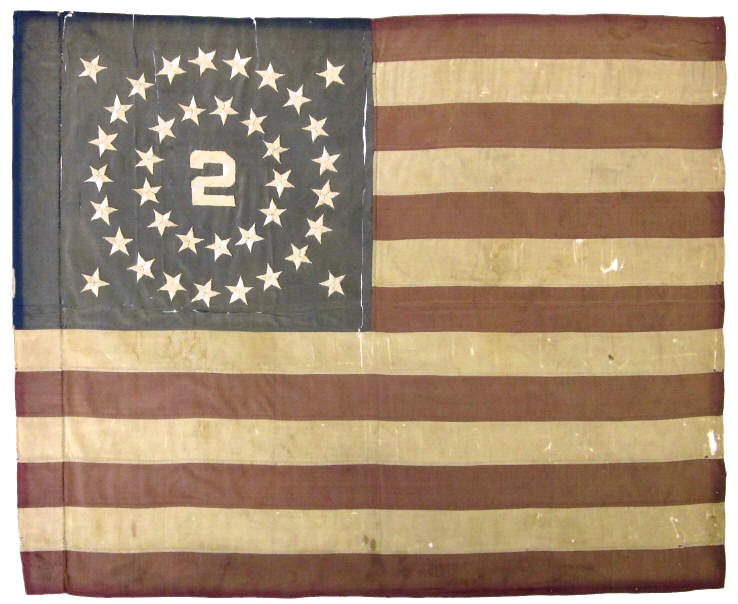
This extraordinary
Indian Wars era flank marker was made for the U.S. 2nd
Infantry Regiment, which has served the United States
for more than two hundred years. The 2nd Infantry
Regiment is the third oldest regiment in the U.S. Army,
with history dating to 1791 and an active lineage that
extends to 1808. Its engagements include the War
of 1812, the Mexican War, the Civil War, the Indian
Wars, the Spanish American War, the Philippine
Insurrection, World War II, the Vietnam War, Kosovo and
Operations Enduring Freedom and Iraqi Freedom.
During the period where this flag was in use, the unit
served in the Washington, Oregon and Idaho Territories
(1877-1886) and then moved to Fort Omaha, Nebraska in
1886, remaining in the western plains until 1898.This silk flank marker
of 38 stars would have been carried by the soldier on
the ends or flanks of the unit when maneuvering in
formation. Its stars and unit designator are
expertly embroidered using silk thread. The flag's hoist
is a sleeve hoist made from the canton and stripes.
This was often done on military flags, and is a trait
also seen on small Union Camp Colors from the Civil War
period.
Regulation military flags from the 19th Century are both
rare and historically fascinating. They are rare
because, unlike commercially manufactured flags,
flags ordered for the military and produced under U.S.
Government contract were produced in very limited
quantities, and, in the case of flags such as this, were
even customized for a particular military unit.
These factors, and the fact that they were typically
carried in the field and therefore subjected to the
elements which would cause them to become worn and unserviceable,
means that very few have survived. They are
historically fascinating, especially when they can be
definitively associated to a particular unit, because
it's then possible to research and learn the historical
particulars of the actual unit that carried the flag. At
one time, most likely many years ago, this flag was
framed for presentation before the introduction of UV
protective glass. The flag was exposed to direct
sunlight for a prolonged period of time, which faded the
silk on the obverse, though the reverse remains its
original vibrant blue and red coloration. The
fading is simply a part of the history of the flag, and
in my opinion, makes it no less desirable, and certainly
no less rare. It remains a beautiful, historic flag that
saw service with one of America's most storied military
units, from the Battle of New Orleans in 1815, to Bull
Run and Gettysburg, to the breakout of Normandy as part
of Patton's 3rd Army, to Kandahar Province, Afghanistan.
|

